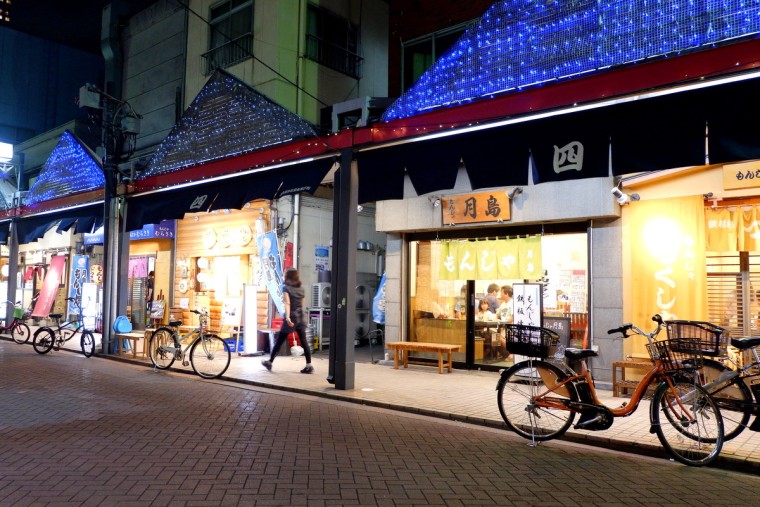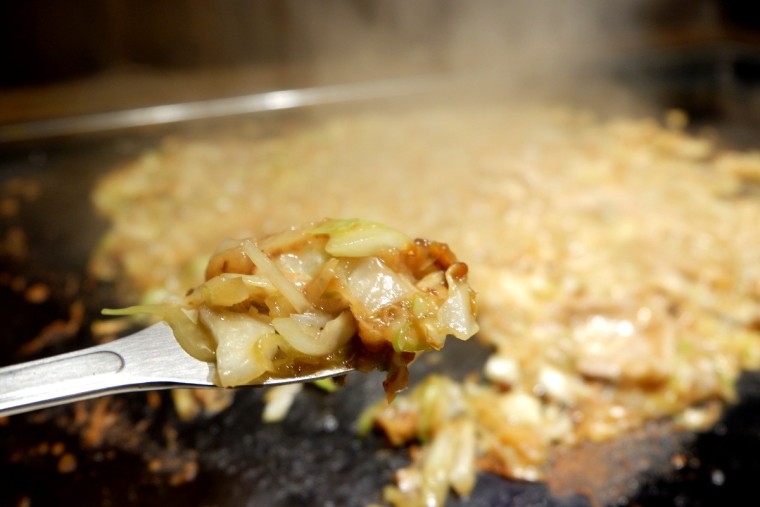Despite being one of Tokyo’s specialities, monjayaki is probably the least known Japanese food outside of Japan. It is often described as a runnier version of Osaka’s famous savoury pancake, okonomiyaki. Monjayaki’s questionable appearance may be the reason it gets looked over, but don’t let that fool you—it’s a delicious and fun dish to make.
Monjayaki is said have evolved from mojiyaki, a popular snack among children in the late 19th century. Mojiyaki literally means grilled letters. Kids would practice writing the Japanese alphabet using batter on hot iron plates set up at the front of snack stores. A few decades on, WWII happened and food suddenly became scarce. In the downtown area of Tokyo, people came up with an inexpensive and easy meal. Inspired by mojiyaki, they cooked batter on hot plates and added chopped vegetables to make it more nutritious. The original monjayaki were made simply of dashi (fish-based stock), flour and cheap ingredients like cabbage. Over time, monjayaki went from being a street food to being served in restaurants.
Today, the majority of monjayaki restaurants in Tokyo are found in two areas on the east side of the city. Asakusa, Tokyo’s downtown area, is one place full of specialty restaurants. It’s great to combine a visit to Senso-ji Temple with lunch at a nearby monja restaurant. The other area is on one of the artificial islands in Tokyo Bay. Tsukishima has so many monja restaurants that the main street is even called Monja Street!

Monja Street, Tsukishima


Monja Shinanoya has good reviews online
In a monja restaurant, every table has its own teppan (hot plate) embedded in the middle. Diners choose from a menu and cook the dish themselves—or get the waiter to help. Some common toppings include mochi, cod roe, prawns, squid, tuna, pork strips, cheese and corn.
In general, everything is served in one bowl. First, you use the two large spatulas to scoop out the ingredients onto the hot plate. The fun part is using the spatulas to furiously chop everything up to make it easier to eat. You have be quick! Then you make a well in the middle and pour in the remaining batter. Mix it all up and spread it out over the whole plate. Let it cook for a few minutes and thicken up. Then it’s time to dig in! You should use the small spatula to pick up the monjayaki and eat it straight away. The crispy edges are especially delicious.


All the ingredients in one bowl




Have you ever tried monjayaki? What do you think of the idea of cooking your own meal at restaurants?
***
Other posts in the “Delicious Japanese Dishes” series:






Looks so good. Thanks for the recipe.
LikeLike
Thanks! It’s a pretty easy recipe. Let me know if you try it!
LikeLike
Very nice pictures, never tried Monjayaki, but I’ll give it a try if the opportunity arises. 😊
LikeLike
Thanks Ana! It was delish. Hope you get to try it one day!
LikeLiked by 1 person
Oh it looked sooo good! I know, sure hope so! 😊🙌🏽
LikeLiked by 1 person
I’ve never even heard of monjayaki, let alone tried it! But thanks to you I’ll keep my eyes peeled for a restaurant that serves it in my city. Great post, Celia!
LikeLike
Thanks Heide! It’s such a fun dish and you can add basically anything you want to it. Let me know if you find a restaurant that serves it!
LikeLiked by 1 person
This is something I have never tried. It became popular (like that dipping ramen) long after I left Japan. I am not sure I would like it. Most of these ingredients would make a nice okonomiyaki–and that is what I want.
LikeLike
Yes, okonomiyaki is definitely more popular despite them having very similar ingredients. I guess texture does play a big part! Monjayaki is something different to try, and as far as I know only available in the Kanto region or some okonomiyaki restaurants around the country.
LikeLiked by 1 person
もんじゃ焼きという料理名を初めて聞きました。もんじゃ焼きには卵を入れないで、小麦粉とだしだけでタネを作ってあるので、お好み焼きのようにふくらまないようですね。
もんじゃ焼きは薄焼きで、お好み焼きは厚焼きという感じがします。セリアさんはどちらが好きですか。満腹感があるのは、お好み焼きを食べた時の方でしょうか。
LikeLike
そうなんですか。機会あれば、ぜひ食べてみて下さい:)
味に関して私は両方とも好きです。しかし言われた通り、もんじゃ焼きは薄焼きだから、あまりお腹がすいていない時のほうがいいと思います。
LikeLike
This is the first time I hear about monjayaki and from the way you describe it the process of making it sounds like really fun! I’m quite surprised though to know that mochi is also used as one of the optional ingredients to make monjayaki as I always associate the glutinous rice cake with desserts. Have you tried mochi monjayaki?
LikeLike
You’re right – mochi is more commonly found in desserts, but it’s sometimes also used in soups and other hot dishes. I haven’t tried mochi monja yet, but I think I might next time! So far I’ve only had seafood and pork ones, but there are so many variations depending on the restaurant. Let me know your thoughts if you ever try it!
LikeLiked by 1 person
I do not enjoy cooking at restaurants, I think I might as well just stay home and cook it my way! I think I will give monjayaki a try, thank you for the interesting history and your neat way to engage the reader in the story with great photos.
LikeLike
Thanks for reading! Haha, yeah that’s true… though one positive is you can make all the mess you want and you don’t have to do the washing up!! :P
LikeLike
True, as well! :)
LikeLike